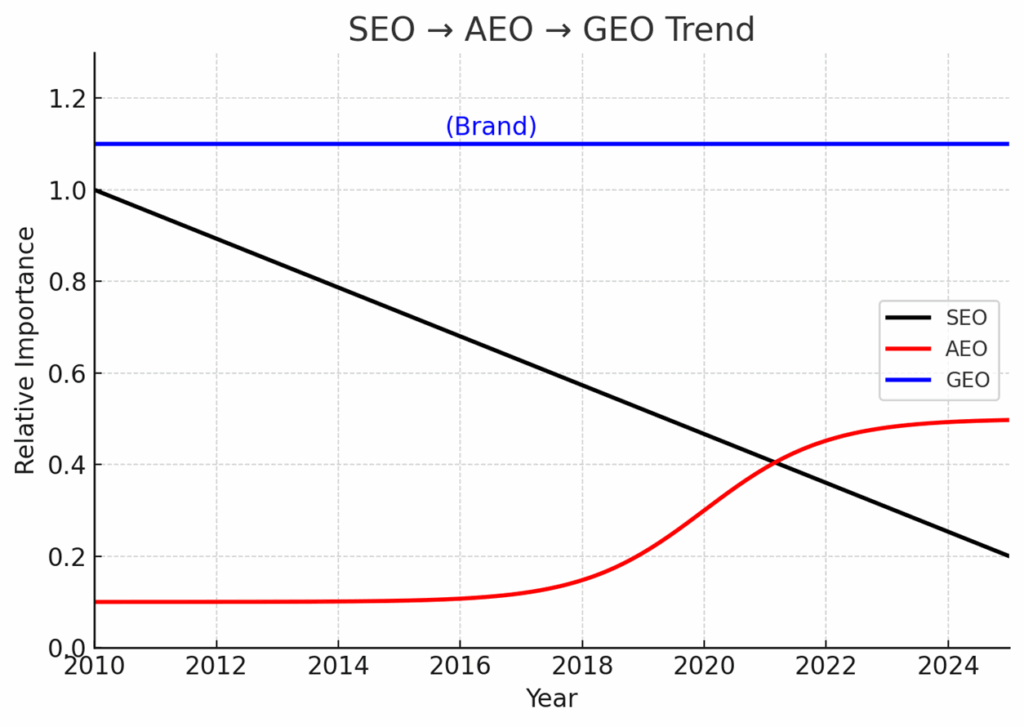Brand is How You
Impact GEO
For as long as there have been marketing departments at tech firms, there’s been one problem that no-one could quite solve: how to measure the impact of brand work.
Finally, measurement of GEO performance gives us a way forward – as a measure of prior credences for your brand.
Visibility
Be findable in AI answers — shape how generative models represent your brand across search, assistants, and emerging discovery platforms.
- Understand the difference between GEO (long-term visibility) and AEO (short-term inclusion)
- Learn how AI search is changing brand measurement
- Design content that becomes part of the “priors” AI models draw from

Some Terminology
1. Generative Engine Optimization (GEO)
Generative Engine Optimization is the long-term, strategic discipline of shaping how AI models represent your brand. Just as people update their beliefs through a psychological process known as Bayesian updating — weighing prior knowledge with new evidence — generative engines “learn” by integrating past training data with structured content and live signals. GEO is about planting those seeds: ensuring your brand becomes part of the “priors” that AI systems draw on when generating answers.
- Why it matters: As AI search and assistants mediate more customer journeys, the brands that appear as default recommendations will win trust and market share.
- How I help: I can design a strategy to embed your expertise and positioning into the sources that generative engines consume — from structured content and metadata to thought leadership designed for long-term AI visibility.
2. Answer Engine Optimization (AEO)
While GEO is slow and cumulative, AEO is faster and tactical. It focuses on ensuring your content surfaces in AI-generated answers today — through schema markup, FAQs, structured comparisons, and intent-driven content that aligns with how tools like Google AI Overviews, Bing Copilot, and Perplexity present information.
- Why it matters: This is the new equivalent of performance marketing. Quick to test, measurable, and effective for capturing demand.
- How I help: I can audit your existing content, identify missed opportunities for answer inclusion, and create structured assets that can deliver visibility within days or weeks.
What Has This Got to Do With Marketing
For as long as I’ve worked in marketing, there’s been one problem I could never quite solve: how to measure the impact of brand work.
We’ve always had solid tools for performance — clicks, conversions, funnel stages. But brand strength? Hand-wavey and unmeasurable. I’ve tried surveys, awareness studies, proxies like search volume. They gave some data, but they were slow, expensive, and rarely told us what people actually thought at the point of decision.
That’s why I find AI search and generative engines so interesting. I believe for the first time, we can open that black box and see the impact of your brand in action.
The Measurement Problem
When I’ve been a CMO, I always felt the tension between what the numbers said and what the market was actually feeling. Performance dashboards looked precise, but they ignored the harder question: what position does our brand hold in people’s minds?
Surveys and brand trackers tried to answer this, but they were blunt instruments. They lagged behind reality and rarely influenced day-to-day decisions.
So “brand impact” remained something we talked about, but couldn’t measure in any meaningful way.
AI as a Brand Mirror
Generative engines don’t just list links. They generate answers — which means they have to synthesize a point of view.
When someone asks an AI tool about your category, the answer is shaped by:
- What the model has learned over years of training.
- What it’s picking up now from your site, your thought leadership, your competitors.
That makes AI outputs a kind of brand mirror. They show what the system thinks your brand (or your category) stands for in real time. As mentioned here, “Brand” can be considered as the priors in a Bayesian model where they represent previous knowledge that we bring when making a product selection. Simply put your prior knowledge that you love Apple products has to be considered when you are searching for a product solution – you are unlikely to buy the new expensive iPhone because of a feature list
The big difficulty as we all know as marketers is that non-marketers don’t get this. This is partly our fault of course, we are notoriously bad at “Marketing marketing”. And I don’t think words are enough – we need some maths! we need to understand why these things are related at a deeper level. Then, the next time when your boss says “Why are we spending all this money on brand advertising can’t we just get some leads?”, you can link these two things together (brand spend and company performance) much more directly.
So GEO is a new and exciting frontier. But how can we measure its impact?
Five Ways AI Visibility Changes Brand Measurement
- It’s real-time – no more waiting six months for a brand tracker; AI outputs shift as your content does.
- It’s observable – you can literally see how your brand is described in answers, not just infer it.
- It’s comparative – you can check not only how you appear, but how competitors are framed.
- It’s testable – publish new messaging or thought leadership and see if it shows up in generative answers.
- It’s scalable – instead of surveying a few hundred people, you’re checking the same engines millions already use.
Why This is a Breakthrough
For the first time, we can ask: what does AI say about us? And we can track how that changes.
- Publish new messaging → does it appear in AI answers?
- Run a campaign → does it shift how the category is described?
- Invest in thought leadership → does it influence which sources are cited?
That’s measurable brand impact. Not perfect, but visible in a way it’s never been before.
How I Help
This post is part of a wider project I’m running here on bjrees.com. Over the next few weeks I’ll:
- Publish structured content designed to test how AI engines update their outputs.
- Track before-and-after snapshots in Perplexity, Bing, and ChatGPT.
- Share the results, whether they work in my favour or not.
If brand has always been the hardest thing to measure, maybe AI finally gives us a way in.
